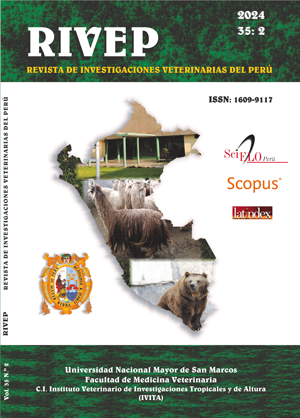Characterization of creole sheep in the communities of the Lambrama district (Apurímac, Perú)
DOI:
https://doi.org/10.15381/rivep.v35i2.25422Keywords:
creole sheep, live weight, carcass weight, fleece weight, textile characteristicsAbstract
The study was carried out with Creole sheep in flocks from the communities of Cruzpata and Siusay, both in the Lambrama district, Apurímac, Peru. The study aimed to characterize its productive capacity for meat and wool. Samples were taken from 60 sheep from two flocks to determine live weight, carcass weight, carcass yield, fleece weight and lock length. In addition, using 187 sheep from six flocks from the same area, samples of rib wool (10 g) were taken for analysis using OFDA 2000 equipment. The phenotype of the Creole sheep presents an angular body covered with fleece of various colours; bare face, belly and long legs, which grazes the puna, in an extensive system and without technical support from the State. Live weight, carcass weight and carcass yield are low, mainly affected by age, with variations like what occurs in other places in the mountains; Measurements of fleece weight and lock length are affected by age and sex, and by the lack of periodic shearing. The textile characteristics of the wool show medium fineness, with high variability, with relatively high comfort and spinning fineness indexes; better on the fleece of two-toothed females. The most important correlations were between fibre diameter (DM) and comfort factor (FH) (r=-0.5925); between DM and fineness of yarn (FH) (r=0.5857) and between FC and FH (r=-0.8767), which would indicate that the wool from the Lambrama area is of good quality for the textile industry.
Downloads
Downloads
Published
Issue
Section
License
Copyright (c) 2024 V. Machaca Machaca, V. Cano Fuentes, V. Paucara Ocsa, A. V. Bustinza Choque, A. D. Machaca

This work is licensed under a Creative Commons Attribution 4.0 International License.
AUTHORS RETAIN THEIR RIGHTS:
a. Authors retain their trade mark rights and patent, and also on any process or procedure described in the article.
b. Authors retain their right to share, copy, distribute, perform and publicly communicate their article (eg, to place their article in an institutional repository or publish it in a book), with an acknowledgment of its initial publication in the Revista de Investigaciones Veterinarias del Perú (RIVEP).
c. Authors retain theirs right to make a subsequent publication of their work, to use the article or any part thereof (eg a compilation of his papers, lecture notes, thesis, or a book), always indicating the source of publication (the originator of the work, journal, volume, number and date).



